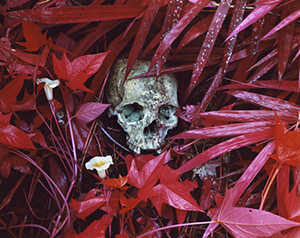It wasn’t until he began taking a more artistic approach that Richard Mosse felt his photographs were truly capturing the horror of the conflict in the Congo, the artist told a group of undergraduates and graduates on Feb. 5.
Mosse spoke about the process behind his most recent project, “The Enclave,” at the Yale School of Art. The talk was sponsored by the Poynter Fellowship in Journalism.
“The Enclave,” a multimedia installation of film and photography taken during his time in the war-torn Democratic Republic of Congo, recently represented Mosse’s home country of Ireland at the annual International Art Exhibition in Venice. Mosse, however, never expected the kind of success and critical praise his work has received, he told his audience.

“Of Lilies and Remains” by Richard Mosse, part of his project “The Enclave.” Image credit: Yale University
Before he embarked on his first trip to the Congo and began the work that would become “The Enclave,” Mosse said, he felt confused and hopeless. “I was in a peculiar place. … I wanted to go to a place in my practice that I had had never done before, to take my genre and throw it against the wall to smash it open.”
Having photographed other post-conflict zones in the Balkans and Iraq, Mosse said, he began to understand the limitations of documentary photography. By focusing on a more artistic kind of photography instead, he said, he found he could tell the story of these war zones that seemed invisible or intangible. He credited contemporary art with giving him “the potential to make visible things beyond the limit of language.”
For his trip to the Congo, Mosse purchased a Kodak infrared film that had been developed by the military to detect camouflage.
Yet when he returned from his first trip to Congo, Mosse was still uncertain about the project. “It took me months to process what this meant emotionally,” he explained. “If I hadn’t given myself more time [before returning to Congo] maybe I wouldn’t have gone forward with the project.” It was not until later that he understood the weight of his work and the value in using the infrared film, Mosse said.
“The [infrared] film allowed me to step over the threshold into this very kitschy universe,” Mosse said. “It worked in an invisible spectrum.” This idea became important as his project continued to develop, said the photographer, and he began to see that so much of the violence was invisible to the camera’s lens. Inspired by this new understanding, Mosse honed his project during several follow-up trips to the Congo, with the goal of making it into something very new and different.
“It was like that Samuel Beckett quote, ‘Try again, fail again, fail better,’” explained Mosse. “That’s really what Congo was all about for me.”
– By Emily Ullmann
*Source: Yale University
